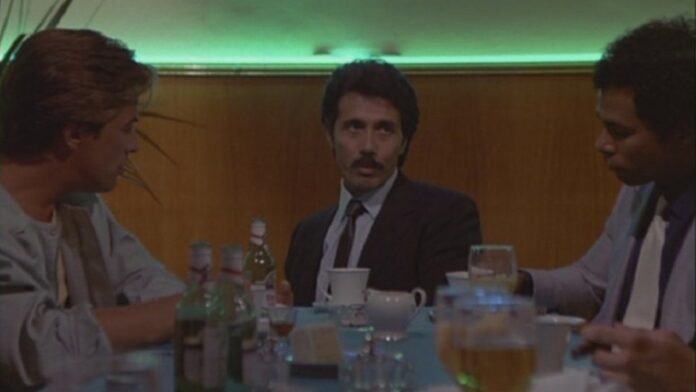Miami Vice
Season 1, Episodes 13 and 14: “Golden Triangle” Parts 1 and 2
Original airdates: Jan. 11 and Jan. 18, 1985
In a prior episode of Miami Vice, Sonny, and Tubbs attempted to prevent a group of kids from getting involved in the drug trade but were ultimately unsuccessful.
As I mentioned a couple of weeks ago (and as everyone generally understood beforehand), it’s quite typical – even necessary – for television series to develop their supporting characters during the midsection of the first season.
While Miami Vice manages to maintain its appeal through well-structured (though somewhat formulaic) cases, striking visuals, and a compelling central performance, any show benefits from enriching its ensemble with likable or, at the very least, familiar characters.
A commonly employed method for achieving this is by unveiling a multitude of secrets held by Supporting Character X, secrets previously unknown to the show’s main protagonists.
Following Gina’s breakthrough episode in “Give a Little, Take a Little,” it was only a matter of time before the show turned its attention to Lt. Martin Castillo, portrayed by Edward James Olmos, the extraordinarily stern, direct, and secretive boss.
Similarly, it was inevitable that “Vice” would gradually unveil significant secrets from Castillo’s past.
The result is the epic, compelling, and occasionally absurd two-part storyline, “Golden Triangle,” which transforms Castillo from a tightly controlled and methodical supervisor into an individual willing to let his emotions cloud his judgment in a high-profile case, mirroring Crockett’s struggles.
I have mixed feelings about “Golden Triangle.” On one hand, as an exploration of Castillo’s background, it’s an outstanding episode featuring an Emmy-winning performance by Olmos.
These episodes unveil intriguing details about Castillo, yet they manage to align these revelations with our existing understanding of the character from the previous few episodes.
We discover that he worked for the DEA in Southeast Asia, specifically in the region known as the Golden Triangle, which led to conflicts with the CIA when that agency, for political reasons, turned a blind eye to major drug trafficking operations.
However, none of this information feels out of place.
Castillo is a reserved and quiet individual, and it’s reasonable to assume he would become such after the perilous life he lived in the 1970s.
Moreover, it’s entirely plausible that he would cause problems for other agencies while working for the DEA, given that he’s not the kind of person to ignore high-functioning drug operations simply.
The most striking revelation of all proved to be the most effective: Castillo had a wife during his time in Asia, whom he believed to be long gone until the events of this episode unfolded.
While the character never entirely sheds his stoic exterior, he becomes notably more passionate and invested in the case’s outcome once he learns that A) his wife is alive and B) she might be in jeopardy.
The scene in which Castillo reunites with his wife, discovering that she thought he was deceased, and they subsequently decided to remarry and have a child, is expertly portrayed by Olmos.
Outwardly, Castillo remains as composed as ever, fully aware of the unfortunate reality of the situation.
Nevertheless, beneath the surface, he appears shattered.
Lines like “I’ve found you only to lose you again” might be cheesy, but Olmos’s performance imbues them with authenticity.
So, on one hand, the Castillo storyline in “Golden Triangle” is exceptionally well-crafted.
On the other hand, it’s yet another instance of “Vice’s” sprawling, almost overstuffed two-part episodes that, in some respects, appear never-ending.
I admire the show’s ability to construct these intricate and extended procedural cases with multiple layers, and numerous secondary and tertiary characters, week after week.
“Vice” essentially delivers stories that have a cinematic quality, and when the narrative spans two episodes, that cinematic feel is further enhanced.
While I wouldn’t describe these two partners as hard to follow, they do tend to become rather intricate.
In the span of these 85 minutes, the episode transitions from a whimsical and entertaining narrative of Crockett collaborating with a prostitute to the team’s pursuit of more dangerous individuals, culminating in the significant revelation that the entire operation is linked to the most extensive drug cartel in Southeast Asia.
Moreover, the head of this colossal cartel is en route to Miami.
This escalation is reasonably effective, primarily due to Castillo’s personal involvement and his connection to the cartel’s leader, Lao Li.
However, it does seem rather convenient that Crockett and Tubbs stumbled upon one of the most significant cases they could have encountered.
I understand that this is television, but perhaps I’m a tad disheartened because I genuinely enjoyed the lighter camaraderie between Crockett and the lady of the night.
Nevertheless, the extended runtime of the episode compels the show to introduce numerous characters and subplots.
Even Noogie makes a brief appearance.
Nonetheless, it’s Olmos’s portrayal of Castillo that steers “Golden Triangle” through its rough patches and minor complexities in the Miami Vice.
He engages in battles, experiences love and loss expresses his emotions fervently, and even dons a Speedo!
Also Read: Review: Beauty and the Beast “Temptation” and “Promises of Someday”


